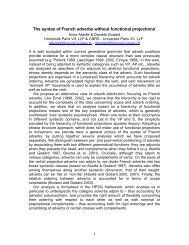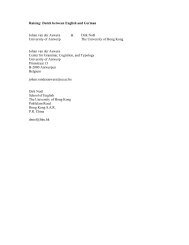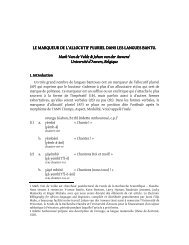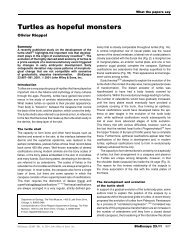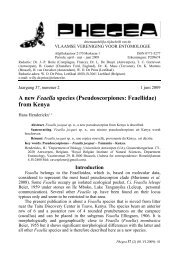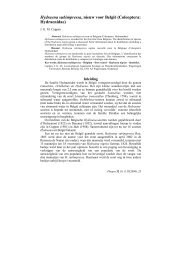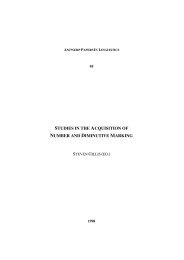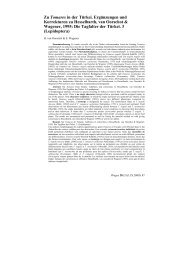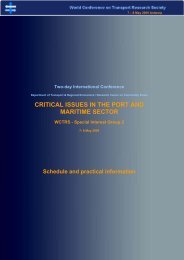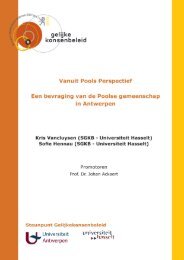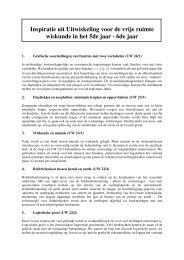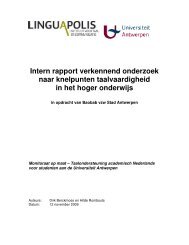Theodor2005.pdf
Theodor2005.pdf
Theodor2005.pdf
Create successful ePaper yourself
Turn your PDF publications into a flip-book with our unique Google optimized e-Paper software.
162 Theodor and Foss<br />
sister-group to a monophyletic Artiodactyla + Cetacea (Cetartiodactyla) (Thewissen et al.,<br />
2001); and one in which mesonychids are the sister-taxon to a paraphyletic Artiodactyla.<br />
In the latter topology, Cetacea is nested within the Artiodactyla as the sister-taxon to the<br />
extant hippopotamids (Geisler and Uhen, 2003). The new fossils have refuted a sister-taxon<br />
relationship between whales and mesonychids, and affirmed a strong relationship between<br />
whales and artiodactyls, but have not provided strong support for a whale–hippo relationship.<br />
This is not surprising, given that early whales and all artiodactyls share the character of<br />
the double-trochleated astragalus, and the new specimens do not seem to provide character<br />
evidence uniquely linking whales and hippos to the exclusion of other artiodactyls.<br />
Morphological suites of characters that support the placement of whales within<br />
Artiodactyla have been difficult to find because the phylogenetic relationships within early<br />
Artiodactyla are poorly resolved (Gentry and Hooker, 1988; Scott and Janis, 1993; Stucky,<br />
1998; Geisler, 2001b) and relevant taxa are poorly represented in many phylogenetic studies.<br />
Aside from Luckett and Hong’s (1998) work on the 6-cusped dp4, little attention has<br />
been paid to other characters of the deciduous teeth in phylogeny reconstructions.<br />
Deciduous dentitions from several genera belonging to the Eocene European artiodactyl<br />
family Cebochoeridae have second and third deciduous premolars (dp2–3) that<br />
possess accessory denticles and resemble the deciduous and adult teeth of derived archaeocete<br />
whales. These teeth do not resemble the adult cebochoerid premolars or any other<br />
artiodactyl dentition (adult or juvenile) we examined. This similarity between cebochoerid<br />
artiodactyls and archaeocete whales has not previously been noted; presumably because<br />
deciduous teeth are seldom preserved, and the resemblances are obscured by wear in most<br />
fossilized deciduous teeth. Among the specimens examined, one particular specimen of<br />
Cebochoerus lautricensis, from the Aquitanian Basin, France, MNHN.EBA 327 (Fig. 1),<br />
has relatively unworn juvenile teeth and displays the unusual morphology also found in<br />
more heavily worn specimens of cebochoerid subadults (Fig. 2(c–f)). The discovery of this<br />
specimen led us to review the deciduous dentition of cebochoerids in more detail, and to<br />
test whether the similarities in the juvenile lower premolars of cebochoerids to archaeocete<br />
teeth represented a synapomorphy or convergence.<br />
MATERIALS AND METHODS<br />
We describe below the deciduous dentitions of the cebochoerid genera Cebochoerus<br />
and Acotherulum, based on the following specimens:<br />
Acotherulum sp.: MNHN.Qu7075, right maxilla with dP2-4, M1-2 (Fig. 3(b));<br />
Qu7076, right dentary with dp3-m2 (Fig. 3(c and d)); Qu98, anterior mandible with fused<br />
symphysis, alveoli for dp1-2, dp3-m1 present; Qu88, right dentary with alveoli for part<br />
of dp2 and dp3, dp4-m3 present, m3 partially erupted; Qu89 ?Acotherulum left dentary<br />
with alveoli for dp1-2, dp3-m1 present. Acotherulum saturninum: MNHN.LDB106, right<br />
dentary with dp3-m1 (m1 broken); LDB107, right maxilla with dP2-M1. Cebochoerus<br />
sp.: MNHN.Qu53 right dentary with broken p1, dp2-m3, m3 partially erupted (Fig. 3(f)).<br />
Cebochoerus minor: MNHN.Qu11283, left maxilla fragment with dP3-M1 (Fig. 3(a));<br />
Qu11284, left maxilla fragment with dP3-M1; Qu65, right dentary fragment with dp3-m1<br />
(Fig. 3(e)); Qu66, right dentary fragment with broken dp4-m2; Qu61, left dentary fragment<br />
with broken dp4-m3, m3 partially erupted. Cebochoerus lautricensis: MNHN.EBA327,<br />
left dentary with dp2-m2 (Fig. 1).



